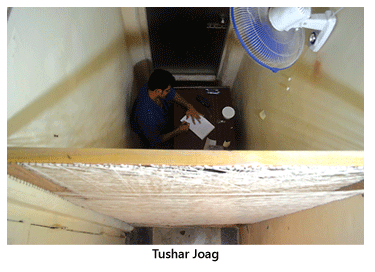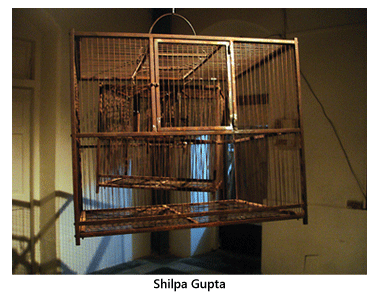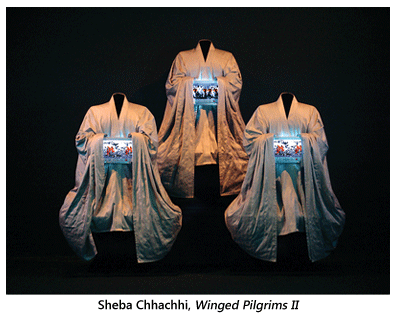- Prelude
- Editorial
- A time to Act
- Raja Ravi Varma: The painter who made the gods human
- Rabindranath as Painter
- Gaganendranath: Painter and Personality
- Abanindranath Tagore: a reappraisal
- Where Existentialism meets Exiledom
- Nandalal Bose
- Jamini Roy's Art in Retrospect
- Sailoz: The Inerasable Stamp
- Amrita Sher-Gil
- Calcutta's Best Kept Secret: The Marble Palace
- Art is Enigmatic
- A few tools to protect the French culture
- The exact discipline germinates the seemingly easiness
- Symbols of Monarchy, power and wealth the Turban Ornaments of the Nizams
- The Bell Telephone
- The Pride of India
- Tapas Konar Visualizing the mystic
- Theyyam
- Our Artists vs. their Artists
- Dragon boom or bubble?
- What Happened and What's Forthcoming
- Art Bengaluru
- Musings from Chennai
- Art Events Kolkata: May – June 2011
- Mumbai Art Sighting
- Previews
- In the News
ART news & views
Mumbai Art Sighting
Volume: 3 Issue No: 18 Month: 7 Year: 2011
June – July 2011
by Jasmine Shah Varma
These days art, activism, intervention are spoken in one breathe. Mumbai had a fair share of such exhibitions. First off, between May 24 and 30, artist Tushar Joag's 'Right to Dissent' took place at an unusual location a damp, atleast one rat-occupied office space in Clark House, Colaba.  The dingy multi-room office with poor lighting was hardly a set up for an art exhibition but all was overlooked considering the project was in support of Dr Binayak Sen. Clearly it was planned when Dr Sen was still imprisoned under the draconian law on sedition. His bail did not deter Joag's efforts in collaboration with the Committee for the Release of Binayak Sen, Mohile Parikh Center - The Contemporary, and Clark House Initiative to make a plea to suspend antiquated laws.
The dingy multi-room office with poor lighting was hardly a set up for an art exhibition but all was overlooked considering the project was in support of Dr Binayak Sen. Clearly it was planned when Dr Sen was still imprisoned under the draconian law on sedition. His bail did not deter Joag's efforts in collaboration with the Committee for the Release of Binayak Sen, Mohile Parikh Center - The Contemporary, and Clark House Initiative to make a plea to suspend antiquated laws.
So an exhibition was planned along with film screenings, discussions and performance of Dasta-e-Sedition over the course of week. Getting to the visual art part of the programme, the highlight of the art exhibition was Joag's six-day performance. The Mumbai based artist isolated himself in a dark space measuring 5x3 feet where on one side was a bathroom door, two sides were walls and the fourth visible to the viewers - was a closely woven white rope mesh. Self-imprisoned, Joag spent his time filling notebooks with the words 'I will not lose faith in the Indian judiciary and democracy'. Visitors were encouraged to write the same in a notebook kept outside the enclosure. Indeed many visitors did write. On the wall close to the cage a butterfly was drawn in pencil formed of words justice, freedom, democracy, equality and so on. On the last day, May 30th, Joag emerged, tearing the rope mesh, like a butterfly out of a cocoon to head to the public discussion with Dr Sen among others.
The performance came across as an emotional idealistic response that had a feel-good factor for the viewers who chose to do their bit by writing in the book in solidarity with Joag. No doubt the artist's personal endurance test was moving to a sensitive audience. Other than that, the message sadly remained cocooned within the walls of Clark House and one doubts how much change this will bring about. The awareness that atrocities as faced by Dr Sen and that outdated laws need to be changed is there among the public and among the literate elite who are the only most likely people to visit an art exhibition in the first place. The purpose of such performances or art interventions seems unfortunately futile much like most art that  is politicised or made in protest.
is politicised or made in protest.
Among other works Sharmila Samant's work packed a clever punch in response to the concern for Dr Sen. In Equations Samant etched on brass plaque witty formulas such as – object minus function equals art; development minus sustainability equals disaster; judiciary minus justice equals Dr Binayak Sen and so on. Under that was a glass box containing hammers also made of glass. Called Glass Hammer, the obvious paradox pointed towards the incongruity of a democracy not allowing its people to voice their opinions freely.
Often art with political slant suffers from being banal and becoming a simplified commentary on complex issues. Wherever the limitations lie, such exercises are hardly salvaged by lazy visual metaphors. Take for example Shilpa Gupta's Untitled work which was made up of a large metal cage enclosing a smaller one and that in turn holding another cage. These cages were suspended from the ceiling distractedly reminding one of Helen's song sequence Piya tu ab to aaja from Caravan. The cage installation, a cry for freedom from unjust laws, is so unlike Gupta's usual complex and layered approach to her works.
Works by other artists featured in the show included those of Anju Dodiya, Atul Dodiya, Bose Krishnamachari, Justin Ponmany, Majlis, Prajakta Potnis, Desire Machine Collective, Reena Kallat, Riyas Komu, Sharmila Samant and Shilpa Gupta. Many of the works were recently seen in an exhibition curated by Mumbai based curator Arshiya Lokhandwala and paled before Joag's and Samant's passionate output.
Right to Dissent came across as an enthusiastic attempt, yet again, to make art a tool for intervention. It surely meant a lot to those involved in it.
Moving image magic
What is it about moving images in an art gallery that makes it more magical than a still image? Are adults at heart still toddler-like to respond more readily to an attractive picture in motion than a still image? At Volte Gallery Delhi-based Sheba Chhachhi's multi-part work Winged Pilgrims: A Chronicle from Asia (2006-2008) created an aura of a magical darkened room full of curios overlapping images some of which moved and some that didn't. Then there were other images held together by arms of body less flowing monk robes drowned in a dramatic light.  Once the eyes adjusted to the spectacle one got down to decoding the images.
Once the eyes adjusted to the spectacle one got down to decoding the images.
Chhachhi has set up light boxes with images on a transparent sheet that moves with the help of a motorised mechanism. Under this layer of moving images is a still image. There are several such boxes lining the wall with different images which are referenced from Chinese paintings, miniatures paintings, Buddhist iconography and there are contemporary photographs of polluted rivers, imaginary urbanscapes, mountains, seas, ancient historical places sites among others. The moving images are stylised portrayals of birds in bright colours. A reference is also made to the avian flu. The birds supposedly play a large role Chhachhi's scheme in creating a metaphor for lost traditions, the culture of consumption, disregard for nature and the globalised world.
The show title calls it 'a chronicle of Asia' but really the dominance of imagery suggestive of China alone cannot be ignored. Perhaps that is because, going by the note on the show, a way for the artist to convey “the mass-produced Chinese goods that flood India today, carrying new forms of globalised culture.” This comes across as a simplfied, selective projection of Asia especially when keeping in mind the show title.
In Winged Pilgrims the artist's concerns, concepts and metaphors are overshadowed by the pretty images referenced from various sources and juxtaposed in the light boxes. Volte Gallery has announced this work is only an introduction to Chhachhi and a full-fledged solo show with more pieces is coming up in 2012.
Luminarium: A Prelude is on till August 1, 2011.